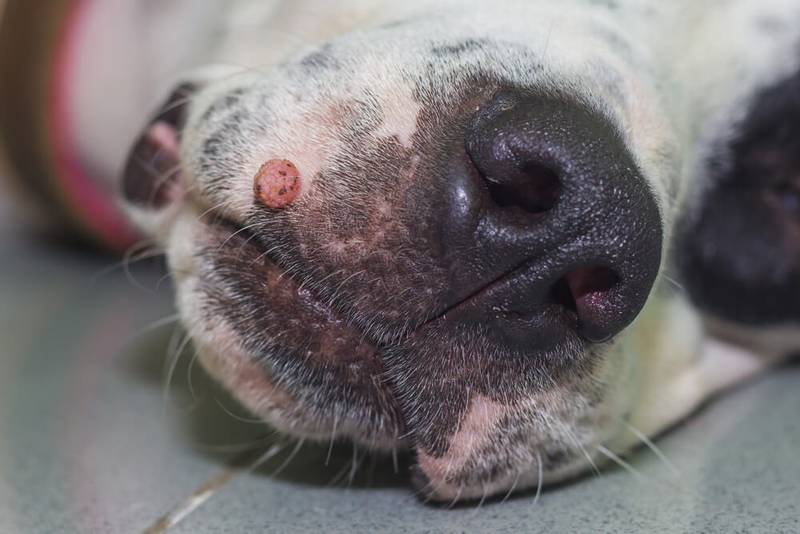Warts are benign changes in the skin that are most common in puppies and older dogs. We clarify what the causes and treatment options of warts in dogs are.
What are Warts in Dogs?
Warts or papillomas are small, benign tumors in the top layers of the skin. They arise spontaneously and become larger and larger over time so that their size can range from a few millimeters to several centimeters.
In dogs, skin warts can be discovered primarily when stroking, because the papillomas are characterized by a knot-like, cauliflower-shaped structure on the skin. Dog warts often have a slightly cracked surface and look dark brown, gray, or black.
Usually, warts are completely harmless and do not cause pain in the dog.
Wart or Tumor in Dogs?
Warts can be mistaken for malignant tumors because of their size and shape. If your dog has warts, watch them closely and have a veterinarian examine them to see if they are a malignant skin tumor or harmless papillomas.
How Do Warts Develop in Dogs?

The most common cause of warts in dogs is canine papilloma virus (CPV). The virus is transmitted from dog to dog and penetrates skin cells. There, the so-called canine papillomatosis stimulates cell division, so that the skin cells multiply in a pathological manner. The excessive skin cell growth becomes visible in the form of small papillomas on the surface of the dog’s skin.
Dogs with a weak immune system in particular often have warts because their immune system fails to fight the papillomavirus successfully. For this reason, puppies with a not yet fully developed immune system, but also older dogs and dogs with previous illnesses, are particularly often affected by warts.
In addition to viral disease and an immune deficiency, a genetic predisposition can also contribute to the development of warts in dogs. As a result, some dog breeds are more prone to warts than others. The most frequently affected breeds include the Cocker Spaniel and the Kerry Blue Terrier.
Are Warts Contagious in Dogs?
Dog warts are not contagious to humans. Both benign skin warts and malignant tumors in dogs are not transmitted to humans. Therefore, if your dog has papillomas, you do not need to worry that you will become infected with a viral disease or develop warts as well.
The situation is different when it comes to the risk of infection for other dogs: the canine papillomavirus is transmitted from dog to dog. If the warts are caused by a viral disease, the virus can be transmitted to other dogs through direct contact. This can also lead to the development of warts in immunocompromised animals. If in doubt, you should have the vet examine whether your dog carries the canine papillomavirus and, to be on the safe side, keep your distance from other dogs for the time being.
What Types of Warts are There in Dogs?
There are several types of papillomas in dogs. Which type it depends on the affected part of the body and the cause. In addition to numerous benign warts, there are also malignant tumors that are often confused with warts and are therefore only recognized late.
- Papillomatosis or mouth warts are benign warts that appear in the area of the mouth, on the lips, or on the lining of the mouth. They can also appear on the dog’s eyes and reproductive area.
- Sebum adenomas are most common in older dogs. They are caused by a blockage of the sebum glands and are benign and not contagious.
- Warts occur in the dog’s reproductive area or at the anus. They are caused by viruses or bacteria and can be contagious.
- Plantar warts or plantar warts are skin growths on the undersides of the paws. Plantar warts are very firm and can seriously affect the dog when walking.
- Squamous cell carcinomas are malignant tumors on the skin or around the mouth. For successful therapy, cancer in dogs must be recognized and treated at an early stage.
When do Papillomas Need to Be Treated in Dogs?
Benign dog warts are often harmless and do not harm the dog. Therefore, in many cases, no treatment at all is necessary. Only when the dog is affected by the papillomas should the growths be treated.
Warts on the dog’s neck or chest in particular can be uncomfortable because the collar, harness, and leash can get caught on warts. The warts are also exposed to strong friction on the legs and face, which can cause warts to be chafed.
In these cases, to prevent infection, you should see your veterinarian see if the wart should be removed. Warts on the mouth and eyes can also be annoying for dogs if their field of vision is restricted or food intake is hindered by skin ulcers.
How Can You Remove Warts in Dogs?
The vet surgically removes warts. It’s a small, straightforward operation under local anesthesia. Depending on the wart, there are different treatment options such as burning the diseased tissue using heat cautery, freezing the tissue using cold surgery, surgical removal of the wart with a scalpel, and laser treatment. Discuss with your veterinarian which surgical method is right for your dog.
Home remedies such as castor oil and thuja should not be used to treat warts without consulting a veterinarian, as many home remedies are toxic to the dog. Surgery is almost always necessary to completely remove papillomas in dogs.

